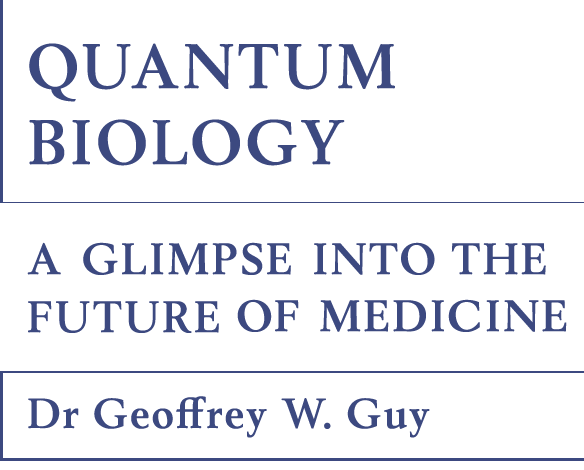
- About Geoffrey Guy
- List of chapters
- 1 Flatworms and xenobots
- 2 Beyond neurons: quantum effects in the brain
- 3 The ghost in the machine
- 4 Inflammation and equilibrium
- 5 The light fantastic
- 6 Lessons from the pandemic
- 7 Reassessing the causes of cancer
- 8 Energy, information and light
- 9 Before the origins of life
- 10 Unravelling the double helix
- 11 The computer in our cells
- 12 Space: the quantum frontier?
- 13 The quantum fractal
- 14 The path to mainstream
- Glossary
- Buy the book



6
Lessons from the pandemic
This page provides online resources relating to Chapter 6 of Quantum Biology: A Glimpse into the Future of Medicine. Read a chapter extract, or scroll down to access figures and terminology, additional resources published by The Guy Foundation, and a list of further reading.
Name of the Chapter
Subheading
It is starting to look as though the real impact of Covid will only come in later life. One of the major objectives of medicine today is morbidity compression, which aims not to make people live longer, but to live in better health nearer the end of their life. I think one of the impacts of Covid is going to be morbidity expansion – the exact opposite of what health professionals have been aiming for. Effectively, people are going to suffer premature ageing because they had Covid. We saw a comparable impact after the 1918 ’flu epidemic when there was an increase in neurological disease among people in their thirties and forties.
When what we call the quantum engine of life is wearing out, Covid accelerates that process. To go back to my analogy of changing the way your car’s control unit functions, it may drive normally for a while. But that will only last until it encounters a problem it can no longer overcome. The human version of that effect is the real worry about the long-term effects of Covid-19.
Buy the book here
Envirogenetics is the combination of environment and genetics. It is the study of the ways in which factors in our external environment such as geography, diet and lifestyle influence our internal environment – our genetics, our physiology and our behaviour. The envirogenetic envelope is the particular combination of all those factors acting on an individual.
Early in the Covid pandemic, the question arose of where had the virus come from. There were many conspiracy theories, but in fact we’d seen something very similar before in terms of SARS (severe acute respiratory syndrome) and MERS (Middle East respiratory syndrome). In both those cases, the virus had originated in animals. The former was in pangolins (also known as scaly anteaters) and the latter was in camels.
In wet markets all over China – including the Wuhan region – it was common for bats to be sold for human consumption. The bat is the only mammal that can sustain flight. So it shares a lot of mammalian systems with other mammals, including humans. But unlike most humans, the bat has to exercise regularly to find food. This provides a powerful and continuous stimulus to maintain functional muscle and mitochondria. In effect, the bat is exposed to regular hormetic stimuli, which could provide clues on how to resist the Covid virus.
When you look at the bat’s mitochondrial function and energy management alongside our own, there are considerable differences. At rest, its function in terms of ATP production is about thirty times more active than that of humans and in flight it’s about 120 times more active.
If we take into account the fact that the system for producing energy and managing mitochondria is also the one that can be recruited to deal with viruses and other infections, it seems that bats can tolerate very high levels of circulating viruses without suffering disease and without upsetting their balance of energy production, inflammation and ROS. All this means that bats are a repository for virtually every unpleasant virus you can imagine, and they have such powerful mitochondria that the Covid virus was probably like a drop in the ocean for them.
I’m sure that if people had been buying and eating bats for a number of years, the Chinese authorities would have known about it. That’s probably why a laboratory in the area where the outbreak was initially reported already had samples of the virus.
Inflammageing is accelerated ageing caused by inflammation. If the normal functioning of a mitochondrion and the other cell components it interacts with begins to be disturbed, the result is increased cellular inflammation. The more inflamed the cell becomes, the more difficult it is to sustain appropriate mitochondrial function.
It’s a vicious feedback circle that leads to other processes which mimic what happens in later life.
The microbiome is a community of micro-organisms living together. In mammals, it is located within the gut. The bacteria in the microbiome aid the digestion of food. They also contribute to regulating the immune system, protecting against disease and producing vitamins.
Quinine has a long medical history. In the 1640s, the governor’s wife in a province of Peru caught malaria and was treated by the local Indians using an extract from cinchona bark. The Jesuits in Peru saw its potential and established trade routes to distribute the bark throughout Europe.
A few years later, Oliver Cromwell died from malaria because he refused to take the same Jesuit bark.
In 1822, quinine became the first chemical medicine to be synthesised.
The Epstein–Barr Virus, one of the most common viruses in humans, is best known as the cause of glandular fever. It is also associated with diseases such as Hodgkin’s lymphoma and rheumatoid arthritis and may be a cause of multiple sclerosis. Like Covid, EBV induces chronic fatigue syndrome. It can alter mitochondrial dynamics, hamper the replication of DNA and impair our anti-virus early-warning systems.
Videos

The Guy Foundation 2024 Spring Series
Thoughts on ageing mitochondria
Professor Nick Lane, University College London (UCL)

The Guy Foundation 2022 Autumn Series
COVID-19, mitochondia and the quantum underground
Professor James Moon, Barts Heart Centre
Professor Alistair Nunn, The Guy Foundation and University of Westminster

The Guy Foundation 2022 Autumn Series
Roundtable meeting
Professor Douglas C. Wallace, The Children's Hospital of Philadelphia Research Institute
Dr Betony Adams, The Guy Foundation and University of Stellenbosch
Also visit The Guy Foundation YouTube Channel Mitochondria Playlist
See the Playlist.
Shahzad Aasim, ‘Quantum theory and its effects on novel corona-virus’, Journal of Quantum Information Science 10:2 (2020), doi.org/10.4236/jqis.2020.102004
Betony Adams, Ilya Sinayskiy, Rienk van Grondelle and Francesco Petruccione, ‘Quantum tunnelling in the context of SARS‑CoV‑2 infection’, Scientific Reports 12 (2022), doi.org/10.1038/s41598-022-21321-1
Selvambigai Manivannan and Kumar Ponnuchamy, ‘Quantum dots as a promising agent to combat COVID-19’, Applied Organometallic Chemistry 34:10 (2020), doi.org/10.1002/aoc.5887
Shashank K. Maurya, Meghraj S. Baghel, Gaurav Vishal Chaudhary, Ajeet Kaushik and Akash Gautam, ‘Putative role of mitochondria in SARS-CoV-2 mediated brain dysfunctions: a prospect’, Biotechnology and Genetic Engineering Reviews (2022), doi.org/10.1080/02648725.2022.2108998
Giuseppe Murdaca, Francesca Paladin, Gabriella Martino and Sebastiano Gangemi, ‘Impact of immunosenescence on viral infections with an emphasis on COVID-19’, Frontiers in Bioscience (Landmark Edition) 28:9 (2023), doi.org/10.31083/j.fbl2809225
Alistair V. W. Nunn, Geoffrey W. Guy, Wolfgang Brysch et al., ‘SARS-CoV-2 and mitochondrial health: implications of lifestyle and ageing’, Immunity & Ageing 17 (2020), doi.org/10.1186/s12979-020-00204-x
Alistair V. W. Nunn, Geoffrey W. Guy, Stanley W. Botchway and Jimmy D. Bell, ‘SARS-CoV-2 and EBV; the cost of a second mitochondrial “whammy”?’, Immunity & Ageing 18 (2021), doi.org/10.1186/s12979-021-00252-x
Mariusz Z. Ratajczak, Kamila Bujko, Andrzej Ciechanowicz et al., ‘SARS-CoV-2 entry receptor ACE2 is expressed on very small CD45- precursors of hematopoietic and endothelial cells and in response to virus spike protein activates the Nlrp3 inflammasome’, Stem Cell Reviews and Reports 17 (2021), doi.org/10.1007/S12015-020-10010-Z
Mina Zare, Mika Sillanpää and Seeram Ramakrishna, ‘Essential role of quantum science and nanoscience in antiviral strategies for COVID-19’, Materials Advances 7 (2021), doi.org/10.1039/d1ma00060h
